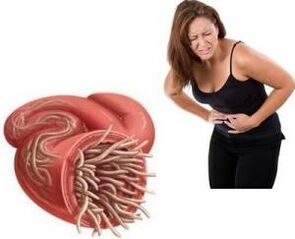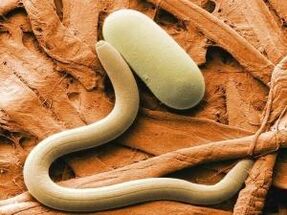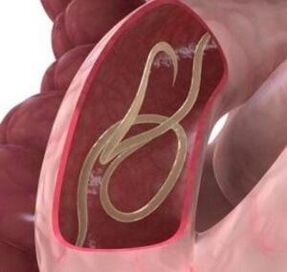Worms are representatives of lower worms that live in the human body. A disease that involves humans being infected with various types of worms is called helminthiasis. This disease is not uncommon and occurs in some segments of the population. Children are susceptible to pinworm infection, hunters - trichinella, fishermen and lovers of Japanese cuisine (raw fish in the form of sushi) suffer from diphtheria.
Paradoxically, many diseases can occur in the human body due to helminths. Today, the theory of the link between cancer and parasitic infections is one of the most relevant. With helminthiasis, symptoms do not always appear and, however, if a patient with this disease experiences any discomfort and discomfort, they are considered signs of other diseases. The patient has been treated for pancreatitis, gastritis or colitis for many years without suspecting that the cause of his illness is helminths.
How does infection happen?

Helminth infections occur as follows:
- Through unwashed hands
- When in contact with soil
- After being bitten by an insect
- Because my hands are dirty
- When eating raw meat or fish
- After eating unwashed fruits and vegetables
- After contact with animals
- After contact with an infected person
Adult parasite eggs can be found in soil, water and food (raw and lightly cooked meat or fish). Rare cases of the disease occur due to insect bites. The mechanism of helminth infection is through the fecal-oral route. A person swallows parasite eggs with food and water. Contact and household methods of transmission also occur. They occur when hands are not washed thoroughly after contact with soil or sand.
Unwashed vegetables and fruits growing underground are also sources of worm infection. Children playing in the yard and pets in the house are at risk of getting worms. Pets roaming the streets can bring helminth eggs into the house. Flies and other insects, after coming into contact with animal feces and landing on food, can easily transmit helminth eggs. Surprisingly, person-to-person transmission is also possible. It happens like this: female pinworms can crawl out of the intestines and lay eggs directly on underwear, causing intense itching. After scratching an itchy area, a person can come into contact with toilet items and other household items. These objects fell into the hands of other family members, who then became infected.
Waterborne infection is also possible. Many parasitic eggs easily fall into ponds and open wells. Drinking unboiled well water is extremely dangerous.
Types of helminth diseases
Helminthiase differs in the method of entering the human body:
- Biological helminths
- Earth worms
- Easy to spread
Biological helminths are transmitted to humans through contact with animals. Earthworms can be infected through soil. Infectious diseases arise from contact with infected people. The disease manifests itself differently depending on the method of infection, the number of worms and the degree of their adaptation in any human organ.
Stages of helminth disease

The most devastating damage to the body is not caused by adults but by their larvae. Adult individuals have chosen for themselves a cozy place in the human body, and the larvae move through the organs and leave their wounds. The most common habitat for parasites is the gastrointestinal tract. Different types of parasites prefer different habitats. So roundworms are located in the small intestine, while pinworms settle in the large intestine and lower part of the small intestine. According to the parasite's habitat, helminth infections are:
- blur
- Cloth
The tissues are located within the lumens of the genital organs and the tissues are located within the tissues. Depending on their development, parasites can change their habitat, switching from lumen form to tissue form. Helminth disease develops in two stages:
- Spicy
- Chronic
The acute phase lasts from a week to a month, the chronic phase continues until recovery. The acute phase begins with the birth of the egg and continues as the parasite matures and develops. The disease is manifested by an allergic reaction to a foreign organism. During the chronic stage of the disease, various reactions of the body occur. During this period, parasites move throughout the body looking for shelter. This disease is accompanied by disruption of the functioning of organs and systems in the human body. After integrating into the human body's immune system, the parasites consume substances necessary for their growth and development. This leads to metabolic disorders, digestive system disorders, and difficulty absorbing vitamins and minerals.
In addition to this harmful effect, parasites also spray their waste into the human body, poisoning the body, leading to intestinal disorders, reduced immunity and the development of bacterial infections. Parasites contribute to the risk of developing cancer. This occurs due to a negative impact on the immune system and stimulation of cell division. Usually, a patient is examined by many specialists and a variety of diseases are discovered in him or her. And in this case, all specialists can be replaced by a single doctor - a parasitologist.
Classification of helminths

Types of worms in humans:
- Flatworms
- Roundworm
Flatworms include:
- trematodes (opisthorchiasis, schistosomiasis, paragonimus)
- Cestodes (broad tapeworm, pork tapeworm, echinococcus, alveococcus)
- Roundworms or nematodes:
- Pinworm
- roundworm
- Hookworms
- Trichinella
This classification of helminths is presented in the medical literature. Successfully solving a problem like helminths requires a deep understanding of the structural characteristics and life cycle of the parasite.
fluke
Another name for trematodes is trematodes. These parasites are flat or lanceolate leaf-shaped with two suckers. One suction cup is located in the mouth and the second suction cup used for attachment is located in the peritoneum. All representatives of trematodes enter the body through an intermediate host. Most of these parasites are hermaphrodites.
opisthorchiasis
This is a fluke - a worm up to 1. 3 cm long with two suction cups. Opisthorchiasis is a hermaphrodite that parasitizes the liver, gallbladder, and pancreas in humans and some carnivores (fox, dog, cat). Opisthorchiasis eggs pass out of the human or animal body in the feces. When these eggs enter a body of water, they are devoured by freshwater molluscs, in which the larvae hatch and develop. The process of development and maturation of the larvae lasts two months. The larvae then crawl out of the mollusk and penetrate the carp's skin. After six weeks, the larvae become fully grown parasites. Opisthorchiasis enters the animal or human body after eating contaminated fish. This worm can live in a living body for up to 20 years. Symptoms of opisthorchiasis:
- Allergy
- Weak
- Headache
- dizzy
- Depression
- Loss of consciousness
Harm caused to the body by opisthorchiasis:
- Parasitic waste poisoning
- Liver tissue damage
- Gallbladder damage
- Impaired bile flow
- Pancreatitis
- Excretory dysfunction
- Reduced gastric motility
- The walls of some organs thicken, leading to the appearance of tumors.
The chronic course of the disease is characterized by:
- Heaviness after eating
- Pain
- Vomiting
- nausea
Prevent infection: To avoid opisthorchiasis, you should not eat raw fish. The larvae die during heat treatment of the product. Dried fish can only be eaten if it has been previously salted. Additionally, larvae will die when fish are frozen for long periods of time.
schistosomiasis

These parasites have different sexes, resembling needles ranging in length from 0. 4 to 2. 6 cm, females are longer than males and larger, laying 3000 eggs per day. The method of reproduction is the same as the previous parasite, via freshwater molluscs. The larvae enter the human body through the skin and mucous membranes while swimming in freshwater bodies. It can also enter the body of people who accidentally swallow water while swimming. After a day of penetration, the larva turns into an adult and enters the peripheral veins, through which it is carried to the lungs and venous blood vessels. There the schistosome reaches sexual maturity.
Schistosoma lays eggs in the intestines, mucous membranes, and bladder. The eggs are then excreted from the human body through urine or feces and their development restarts. Schistosoma lives in the human body for decades, causing harm and infecting new people. The problems that arise when infected with schistosomiasis are caused not by adults but by their eggs. Only half of the eggs are eliminated from the body, the rest accumulate in the organs. The eggs of this parasite have spikes that damage human internal organs, often causing ulcers in infected people. Patients with schistosomiasis have the following symptoms:
- Appetite disorder
- Anemia
- Enlarged liver
- Spleen changes
- Reduced intestinal motility
- Stomach-ache
- Constipation
- Diarrhea
- Losing weight
- Intestinal bleeding
- Pain when urinating
- allergy
- Weak
When the genitourinary system is infected, the patient will experience:
- Irregular menstruation and miscarriage in women
- Impotence and incomplete ejaculation in men
If the egg enters the central nervous system:
- Acute cerebral schistosomiasis
- Chronic brain damage
- Death
Infected children experience delayed growth and development and reduced performance in school. Prevention includes avoiding swimming and walking barefoot in tropical waters.
Paragonim

Paragonim is a 1 cm long lung fluke with an egg-shaped body and red spines. This parasite multiplies in the lungs of animals and enters the human body by eating freshwater crayfish and crabs. Parasites affect the respiratory system. Patients with paragonimiasis are characterized by allergic reactions and reduced immunity. Symptom:
- Increased temperature
- Cough
- Production of phlegm from the lungs when coughing
- shortness of breath
- In severe cases, there is blood and parasite eggs in the sputum
- Wheezing can be clearly heard in the patient's lungs
Prevention: Avoid eating raw crayfish and crabs.
Cestodes
Representatives of cestodes are tapeworms of different lengths. Some parasites reach giant sizes. On the heads of these parasites there are suction cups, hooks or suction slits. Parasites need these devices to attach to the intestinal wall. Cestodes affect the entire human body, they are most dangerous for children, who quickly become anemic.
Echinococcus
These parasites reach a length of 5 cm and are the causative agents of Echinococcus disease. Multicompartmental representatives of this type of worm are the causative agents of diseases such as alveolitis. The disease is transmitted by livestock and domestic animals. When caring for these animals, parasitic eggs from their fur fall onto human hands. When parasites enter the human intestine, they bite into the mucous membrane. When the parasite matures, it develops into four parts, the last of which is filled with eggs. These parts break off and disperse throughout the body, spreading infection. The fourth part spreads eggs all over the body.
The patient's infected organs become enlarged, for example the liver. Pus may form. An enlarged organ can even rupture the abdominal cavity. And this can lead to serious body infections and even death. Symptom:
- Weak
- dizzy
- Allergic reaction to parasite waste.
Echinococcus affects:
- Brain
- Spinal cord
- Eye
- Thyroid
- Liver
- Lung
- Uterus
This parasite can stimulate the formation of tumors, including malignant ones. The most unpleasant thing is that treatment of this disease can only be done surgically. Disease prevention: personal hygiene when contacting animals.
Nematode
These worms have elongated, round or cylindrical bodies, often parasitic in children's bodies. These types of roundworms include pinworms, roundworms, and hookworms.
Pinworm

These are small white worms. The length of the female is 1 cm, the male is 0. 5 cm. These parasites have a pointed tail, so they are called pinworms. The habitat of pinworms is the human intestine. The front end of the parasite has a suction cup that allows the pinworm to drill into the intestine. The sharp end pierces the intestinal lumen and damages the intestinal wall. This disease is called enterobosis. You can get infected from a person through dirty hands. The disease is observed in preschool children who are attending kindergarten. Symptoms of pinworm infection are itching near the anus. More often, the itching sensation occurs at night, when the female lays eggs, secreting a special substance. Symptom:
- Itchy
- Diarrhea
- Stomach-ache
- Headache
- Lack of appetite
Prevention: wash hands.
Roundworm
These worms are the largest. The length of the female is up to 0. 5 m, the female lays 200 thousand eggs per year, regardless of the male. The mechanism of infection is through the fecal-oral route. Roundworm eggs enter the human body with unwashed vegetables and fruits through dirty hands. The larvae enter the intestine, are selected from the shell and penetrate the intestinal wall, and move through the intestinal vein to the liver, through the hepatic vein into the heart, through the pulmonary artery into the bronchi, then into the trachea andinto the mouth. Part of the larvae die outdoors, the rest are swallowed again. Symptom:
- nausea
- Vomit
- jaundice
- Pancreatitis
- Frequent acute respiratory infections
- Bronchitis
- Pneumonia
Prevent:
- Hand washing
- Wash vegetables and fruits
- Maintain personal hygiene
- Protect food from flies, cockroaches and other disease carriers.
In short, it can be said that the cause of disease is not always due to bacteria or viruses entering the body. Parasites can cause enormous harm to human health. If unclear symptoms appear, the possibility of parasites entering the body cannot be ruled out and the patient should see a parasitologist.























